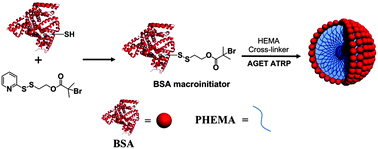In situ fabrication of PHEMA–BSA core–corona biohybrid particles†
Abstract
Polymer–protein core–corona particles can be used as multifunctional platforms in biological and medical applications. In this research, we prepared poly(2-hydroxyethyl methacrylate)–bovine serum albumin (PHEMA–BSA) core–corona particles by the “grafting from” method. In order to prepare the particles, activators generated by electron transfer for atom transfer radical polymerizations (AGET ATRP) of HEMA initiated by a BSA macroinitiator were performed. The polymerizations were conducted in the presence of ppm amounts of transition metal catalyst and ascorbic acid. Transmission electron microscopy, atomic force microscopy, dynamic light scattering and ξ-potential measurements were used to characterize the core–corona particles. The average size and ξ-potentials of the particles are strongly dependent on the amounts of BSA used in AGET ATRP. The secondary structure and bioactivity of the protein molecules in the coronae of the particles were studied. In vitro cytotoxicity assays and cell uptake assays indicate that the biohybrid particles are nontoxic and can be internalized into the cells. The polymer–protein core–corona particles will find applications in drug delivery and biomedical imaging.


 Please wait while we load your content...
Please wait while we load your content...